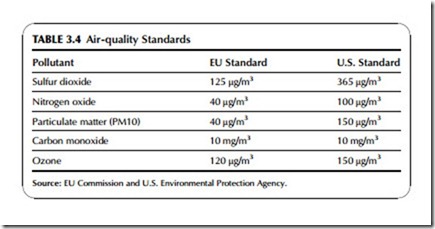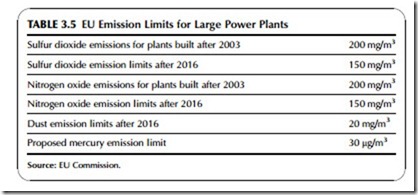EMISSION CONTROL FOR COAL-FIRED POWER PLANTS
The combustion of coal is the dirtiest of the large-scale methods of generating electricity, primarily because of the range of pollutants that are found within the fuel. Most coals contain some sulfur. Often it is more than 3% of the coal and it may reach as much as 10%. When the coal is burned this sulfur is converted into sulfur dioxide and carried off by the flue gases. If released into the atmosphere it can be converted into an acid with potent consequences. There is a small amount of organic nitrogen with coal too. During combustion this is converted into nitrogen oxides of various sorts. However, the main source of these gaseous nitrogen compounds is the nitrogen in air that can become oxidized at the high temperatures encountered within coal furnaces. These two can be potent pollutants.
Coal usually contains a significant amount of mineral impurity too. A large part of this fuses to create solid lumps, which are left behind in the combustion chamber as slag. However, some are reduced to tiny solid particles that get carried away with the flue gas. The particles may contain heavy metals, such as cadmium and mercury, that, if allowed to escape, will be released into the environment. Some coals, particularly the bituminous varieties, contain large amounts of volatile organic compounds and these, or fragments of them generated by their incomplete combustion, can also be released. Incomplete combustion of the carbon in coal may also lead to significant levels of carbon monoxide within the flue gases.
Environmental regulations require that as far as possible these materials are removed from coal-fired power plant flue gases before the latter are released into the atmosphere. Different techniques have been developed for the most important of these: sulfur scrubbers for removing sulfur compounds, low nitro- gen oxide burners and catalytic reduction systems to remove nitrogen oxide, and filters and electrostatic precipitators to control dust emissions. Other trace elements such as heavy metals may require their own removal plants but often these can be tackled alongside one or the other pollutants, making an additional chemical treatment process unnecessary.
Table 3.4 contains figures for the concentrations of various power plant air- borne pollutants that are considered permissible in the EU and United States if good air quality is to be maintained. EU regulations are generally stricter; for example, the EU expects sulfur dioxide concentrations over a 24-hour period to be below 125 mg/m3. In the United States the same standard is 365 mg/m3. How- ever, internationally, standards are tending to converge as the effects of even low levels of pollution on human health become more widely recognized. The PM10 particulate matter standard is for dust particles greater than 10 mm in diameter; this is generally the standard of importance when considering dust from coal-fired power plants. There are other standards including PM2.5 for particles up to 2.5 mm in diameter.
The figures in Table 3.4 apply to the air quality that people will encounter in the street or in their houses or offices when carrying out their daily lives. The actual emissions permitted by power plants are generally much higher than this. A power plant represents a concentrated source of pollutants, but these are released in hot gases from a tall stack so that they should rise high into the atmosphere and become diluted before humans or other life-forms come into contact with them. However, the behavior of the pollutants once they enter the atmosphere is not always predictable. The behavior of the plume of exhaust gases from a power plant stack will depend on atmospheric conditions, so sometimes the pollutants will fall close around the plant and at other times they may be carried across continents.
Table 3.5 shows some of the emission levels permitted within the EU for power plant flue gases. The figures are for large plants with a thermal capacity
in excess of 300 MW. The limits are less strict for some smaller plants. For sulfur dioxide the limit for plants built after 2003 is 200 mg/m3, falling to 150 mg/m3 after 2016. Permitted emission levels for nitrogen oxide are the same. Dust emissions are to be below 20 mg/m3 after 2016 and there is a pro- posed emission limit for mercury of 30 mg/m3. As earlier, these EU limits are probably some of the strictest to be found, but as with air-quality standards, the regulations are becoming stricter everywhere.
There is one other important combustion product of coal combustion not included in the preceding tables or discussion: carbon dioxide. This is the reaction product when carbon is burned in air, the reaction of which releases the heat energy used to generate electricity. The flue gases from the boiler of a typical advanced coal-fired power plant may contain up to 14% carbon dioxide depend- ing on the specific plant conditions.
The release of carbon dioxide from the combustion of fossil fuels in power plants and elsewhere into the atmosphere is widely regarded as the main cause for a steady but accelerating rise in average global temperatures over the past 150 years. This is seen as potentially damaging to the global environment. The capture and removal of carbon dioxide from fossil fuel power plant flue gases is not yet mandatory anywhere, but measures to try and control its emissions are being introduced in some parts of the world, particularly the EU. At the same time, methods for capturing the gas are being developed and there is a growing consensus that these will need to be deployed on a commercial scale after 2020 if global warming is to be limited. If this becomes necessary, then coal-fired power plants will be in the front-line since they are the greatest emitters.

